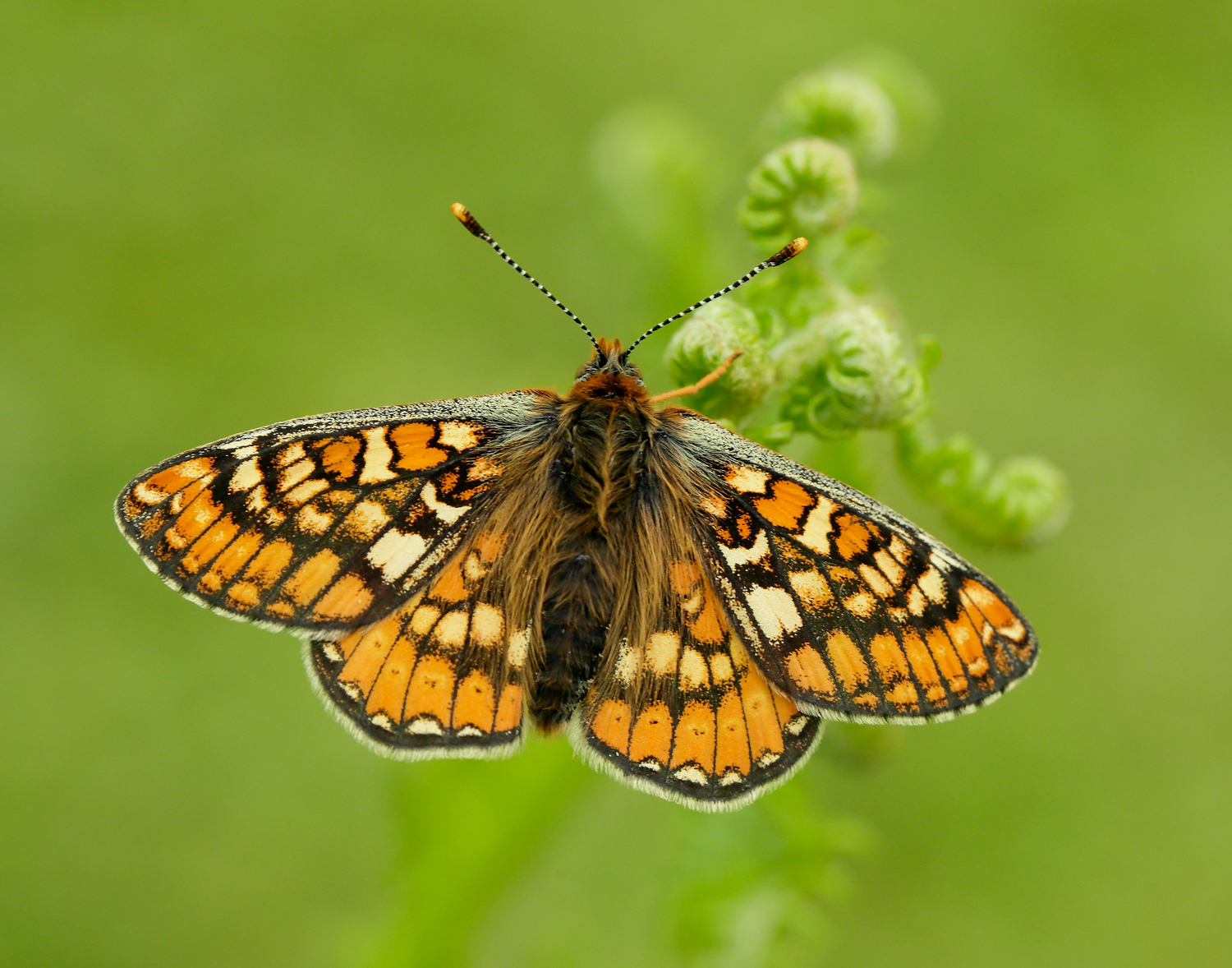Marsh Fritillary (Iain H Leach)
Dr Emily Dennis discusses the headlines from the latest State of Nature Report, including the latest data on butterflies and moths.
Since 2013, every few years the State of Nature report provides an up-to-date assessment of how nature is doing in the UK across land and sea. The latest assessment, the State of Nature 20231, is the fourth report and was released in September 2023, and describes an ongoing decline in UK wildlife, including butterflies and moths.
The report, led by the RSPB, was created by a partnership of over 60 conservation and research organisations, including Butterfly Conservation. The report collates nearly 50 years of data from monitoring schemes and biological recording schemes, collected by many thousands of dedicated volunteers.
Based on Red List Criteria, nearly one in six (16% of 10,000) species were assessed as at risk of being lost from Great Britain. This included assessments from the recently updated Red List for butterflies in Great Britain2, which categorized 41% of species as threatened (Endangered or Vulnerable).
The abundance of 753 terrestrial and freshwater species has on average fallen by 19% across the UK since 1970. Within this average figure, 38% of species have declined in abundance and 27% have increased. The report found that specialist butterflies have declined by 18% on average since the 1970s, but populations of generalist species are stable on average, whereas moths have declined on average by 31%, based on the abundance of 493 species.
The distributions of invertebrates were reported to have decreased on average by 13% since 1970, based on data for an impressive 4,979 species. Distribution trends were also assessed in terms of species which provide key ecosystem functions, finding stronger declines for pollinators (average 18% decrease) and pest controllers (average 34% decrease).
The report also found that out of the assessed habitats which are important for wildlife, only 14% were found to be in a good condition and only 7% of native woodlands and 25% of peatlands were assessed to be in a good ecological state.
Data from Butterfly Conservation contributed to the latest assessment, providing information on the UK’s butterflies and moths. Abundance data was compiled from the UK Butterfly Monitoring Scheme and from Butterfly Conservation’s rare/scarce moth monitoring, as well as from the Rothamsted Insect Survey. The State of Nature draws together information on many taxa, typically in the form of time series from which trends are estimated using suitable statistical methods. For example, for butterflies and moths the Generalised Abundance Index3 approach is typically used to produce indices of abundance, from which species’ trends can be calculated. The method accounts for missing weeks in the data by modelling species’ flight periods. Data from the National Moth Recording Scheme also contributed to the invertebrate distribution trends, which were calculated using an occupancy modelling approach4.
Butterfly Conservation staff were also involved in the report’s production, from helping design the analysis methods used, to describing conservation case studies, for example on habitat management for Duke of Burgundy, resulting in the species being recently down-listed from Endangered to Vulnerable in Great Britian2.
As well as providing an overall assessment of how nature is faring in the UK, separate reports were also produced for England, Scotland, Northern Ireland and Wales, and the UK Overseas Territories and Crown Dependencies are also reported upon.
The recent report featured a multi-taxa indicator to estimate change in species abundance in Wales for the first time, reporting an average decline of 20% since 1994, which included an average decline of 43% in moths (since 1970) and an average decline of 54% (since in 1993) in specialist butterflies, whereas generalist butterfly populations were stable on average. The recent State of UK Butterflies5 report similarly reports upon changes by country, but in terms of distribution as well as abundance. The findings of the State of Nature are similar, where the status of butterflies in Scotland appears more optimistic, since butterfly populations show an increase on average (43%), with a stable average trend for specialist species.
Optimistically, the report also highlights where concerted wildlife conservation action has made a key difference to many species and habitats. With an ongoing growth of data and analysis, monitoring of change improves with each State of Nature report, and thus “we have never had a better understanding of the State of Nature and what is needed to fix it”.
References
- Burns, F., Mordue, S., al Fulaij, N., Boersch-Supan, P.H., Boswell, J., Boyd, R.J., Bradfer-Lawrence, T., de Ornellas, P., de Palma, A., de Zylva, P., Dennis, E.B., Foster, S., Gilbert, G., Halliwell, L., Hawkins, K., Haysom, K.A., Holland, M.M., Hughes, J., Jackson, A.C., Mancini, F., Mathews, F., McQuatters-Gollop, A., Noble, D.G., O’Brien, D., Pescott, O.L., Purvis, A., Simkin, J., Smith, A., Stanbury, A.J., Villemot, J., Walker, K.J., Walton, P., Webb, T.J., Williams, J., Wilson, R., Gregory, R.D. (2023). State of Nature 2023, the State of Nature partnership. www.stateofnature.org.uk
- Fox, R., Dennis, E.B., Brown, A.F. & Curson, J. (2022). A revised Red List of British butterflies. Insect Conservation and Diversity, 15, 485-495. https://doi.org/10.1111/icad.12582
- Dennis, E.B., Morgan, B.J.T, Freeman, S.N., Brereton, T.M., & Roy, D.B. (2016). A generalized abundance index for seasonal invertebrates. Biometrics, 72, 1305-1314. https://doi.org/10.1111/biom.12506
- Outhwaite, C.L., et al., Prior specification in Bayesian occupancy modelling improves analysis of species occurrence data. (2018). Ecological Indicators, 93, 333-343.
- Fox, R., Dennis, E.B., Purdy, K.M., Middlebrook, I., Roy, D.B., Noble, D.G., Botham, M.S. & Bourn, N.A.D. (2023). The State of the UK’s Butterflies 2022. Butterfly Conservation, Wareham, UK. https://butterfly-conservation.org/state-of-uk-butterflies-2022

